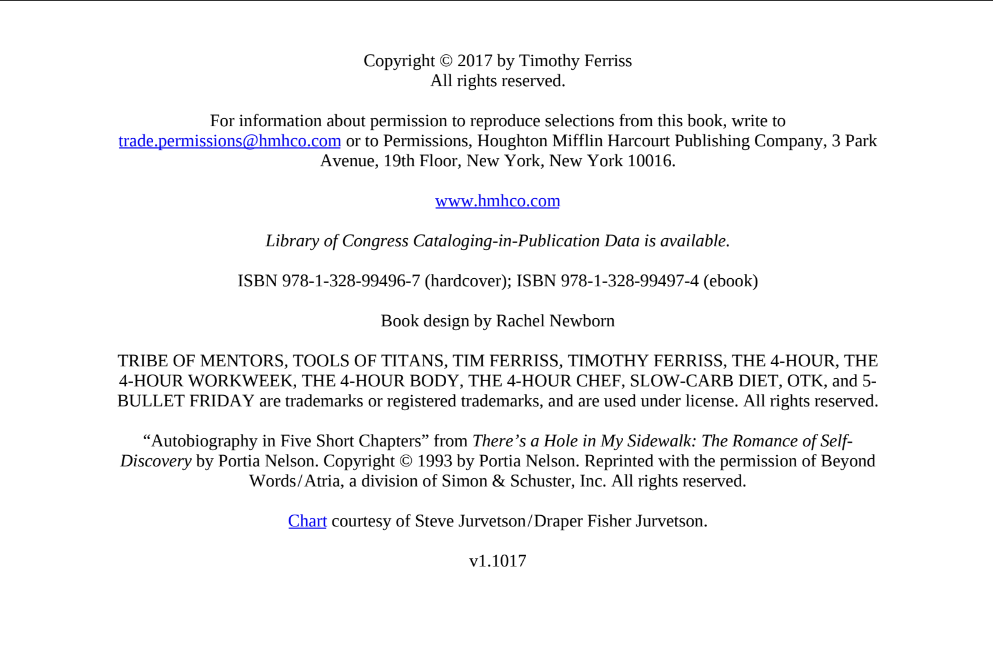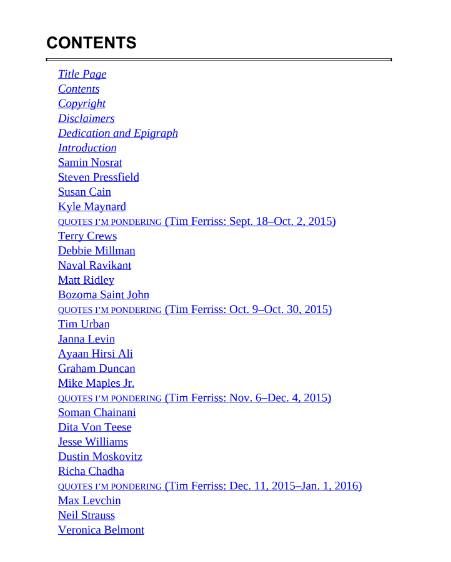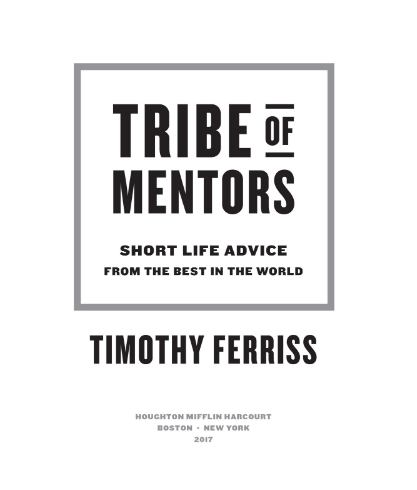


To explain why I wrote this book, I really need to start with when. Two thousand seventeen was an unusual year for me. The first six months were a slow simmer, and then, within a matter of weeks, I turned 40, my first book (The 4-Hour Workweek) had its tenth anniversary, several people in my circle of friends died, and I stepped onstage to explain how I narrowly avoided committing suicide in college.* Truth be told, I never thought I’d make it to 40. My first book was rejected 27 times by publishers. The things that worked out weren’t supposed to work, so I realized on my birthday: I had no plan for after 40.
As often happens at forks in the path—college graduation, quarter-life crisis, midlife crisis, kids leaving home, retirement—questions started to bubble to the surface. *Were my goals my own, or simply what I thought I should want?* *How much of life had I missed from underplanning or overplanning?* *How could I be kinder to myself?* *How could I better say no to the noise to better say yes to the adventures I* *craved?* *How could I best reassess my life, my priorities, my view of the world, my* *place in the world, and my trajectory through the world?* So many things! All the things! One morning, I wrote down the questions as they came, hoping for a glimmer of clarity. Instead, I felt a wave of anxiety. The list was overwhelming. Noticing that I was holding my breath, I paused and took my eyes off the paper. Then, I did what I often do—whether considering a business decision, personal relationship, or otherwise—I asked myself the one question that helps answer many others . . .
What would this look like if it were easy? “This” could be anything. That morning, it was answering a laundry list of big questions. What would this look like if it were easy? is such a lovely and deceptively leveraged question. It’s easy to convince yourself that things need to be hard, that if you’re not redlining, you’re not trying hard enough. This leads us to look for paths of most resistance, often creating unnecessary hardship in the process. But what happens if we frame things in terms of elegance instead of strain? Sometimes, we find incredible results with ease instead of stress. Sometimes, we “solve” the problem by completely reframing it.
And that morning, by journaling on this question—What would this look like if it were easy?—in longhand, an idea presented itself. Ninety-nine percent of the page was useless, but there was one seed of a possibility . . . What if I assembled a tribe of mentors to help me? More specifically, what if I asked 100+ brilliant people the very questions I want to answer for myself? Or somehow got them to guide me in the right direction? Would it work? I had no idea, but I did know one thing: If the easy approach failed, the unending-labor-in-the-salt-mines approach was always waiting in the wings. Pain is never out of season if you go shopping for it. So, why not spend a week test-driving the path of least resistance?
And so it began. First, I scribbled down a list of dream interviewees, which started as one page and quickly became ten. It had to be a list with no limitations: no one too big, too out-of-reach, or too hard to find. Could I get the Dalai Lama? The incredible Temple Grandin? My personal white whale, author Neil Gaiman? Or Ayaan Hirsi Ali? I wrote out the most ambitious, eclectic, unusual list possible. Next, I needed to create an incentive to encourage people to respond, so I worked on a book deal. “Be in my book” might work. From the outset, I told the publisher that it also might not work, and that I’d return the advance if so. Then, I started pitching my little heart out. I sent an identical set of 11 questions to some of the most successful, wildly varied, and well-known people on the planet with “Answer your favorite 3 to 5 questions . . . or more, if the spirit moves you.” After hitting “send” dozens of times, I clasped my hands to my excited writer’s chest with bated breath, to which the universe replied with . . . silence. Crickets.
For 12 to 24 hours, nothing. Not a creature was stirring, not even a mouse. And then, there was a faint trickle through the ether. A whisper of curiosity and a handful of clarifying questions. Some polite declines followed, and then came the torrent. Nearly all of the people I reached out to are busy beyond belief, and I expected I would get short, rushed responses from a few of them at best. What I got back instead were some of the most thoughtful answers I’d ever received, whether on paper, in person, or otherwise. In the end, there were more than 100 respondents.
Granted, the “easy” path took thousands of back-and-forth emails and Twitter direct messages, hundreds of phone calls, many marathons at a treadmill desk, and more than a few bottles of wine during late-night writing sessions, but . . . it worked. Did it always work? No. I didn’t get the Dalai Lama (this time), and at least half of the people on my list didn’t respond or declined the invitation. But it worked enough to matter, and that’s what matters. In cases where the outreach worked, the questions did the heavy lifting. Eight of the questions were fine-tuned “rapid-fire” questions from my podcast, The Tim Ferriss Show, the first business-interview podcast to pass 200 million downloads. These questions have been refined over more than 300 interviews with guests such as actor/musician Jamie Foxx, General Stanley McChrystal, and writer Maria Popova. I knew that these questions worked, that interviewees generally liked them, and that they could help me in my own life.


